Renovated Kerckebosch district Zeist-Oost
For once, I am not starting this walk from an estate or country house, but I am walking with Siena & Giulia from our apartment in the building “Lucht” on Prinses Marijkelaan through our completely renovated Kerckebosch district. Last Saturday, September 28, during “Neighbourhood Day Kerckebosch 2024”, we celebrated in the Binnenbos that the new district has been realised after 15 years of demolition and construction. Accompanied by many photos, I walk from one avenue and neighbourhood to another and you will be amazed by the diversity of houses and apartment buildings that you can find per avenue and neighbourhood in the photo gallery www.als-bomen-en-stenen-konden-praten.com.
Our district is located in the middle of nature and I regularly wake up at night to the call of hunting tawny owls. Their sound sounds chilling in the silence of the night. Besides tawny owls, you can see squirrels, nuthatches, tree creepers, blue tits, great tits, swifts, blackbirds, thrushes, chaffinches, finches, robins, jackdaws, crows, great spotted woodpeckers, black woodpeckers, buzzards, jays, stonechats, heath butterflies, magpies, hawks, deer, slow worms and so on. You can also see a lot of bats in the evening, for which more than 100 bat boxes have been hung in the neighbourhood. The fox walks in the forest behind our apartment building and the wolf has also been seen here a number of times, even right in front of our house and in the neighbourhood.
All drone shots and aerial photos in my story were made by Theo Scholten of driejuni fotografie and he allowed me to use them.
History of Kerckebosch But first I will tell you something about the history of our district. Kerckebosch is named after the Church and Poor Forest that was sold to the municipality of Zeist in 1917 by the Roman Cath
olic Church Rijsenburg due to financial difficulties. The area is 63 hectares or 630,000 m2 and to make it a bit clearer that is 630 x 1,000 meters. The district borders the Zeisterbos to the east and is bordered to the north by the Woudenbergseweg, to the west by the villa district Hoge Dennen and to the south by the Utrecht-Arnhem railway line. The northern border is formed by the Jagerssingel that connects to the Oranje-Nassaulaan that in turn ends at the Arnhemse Bovenweg.
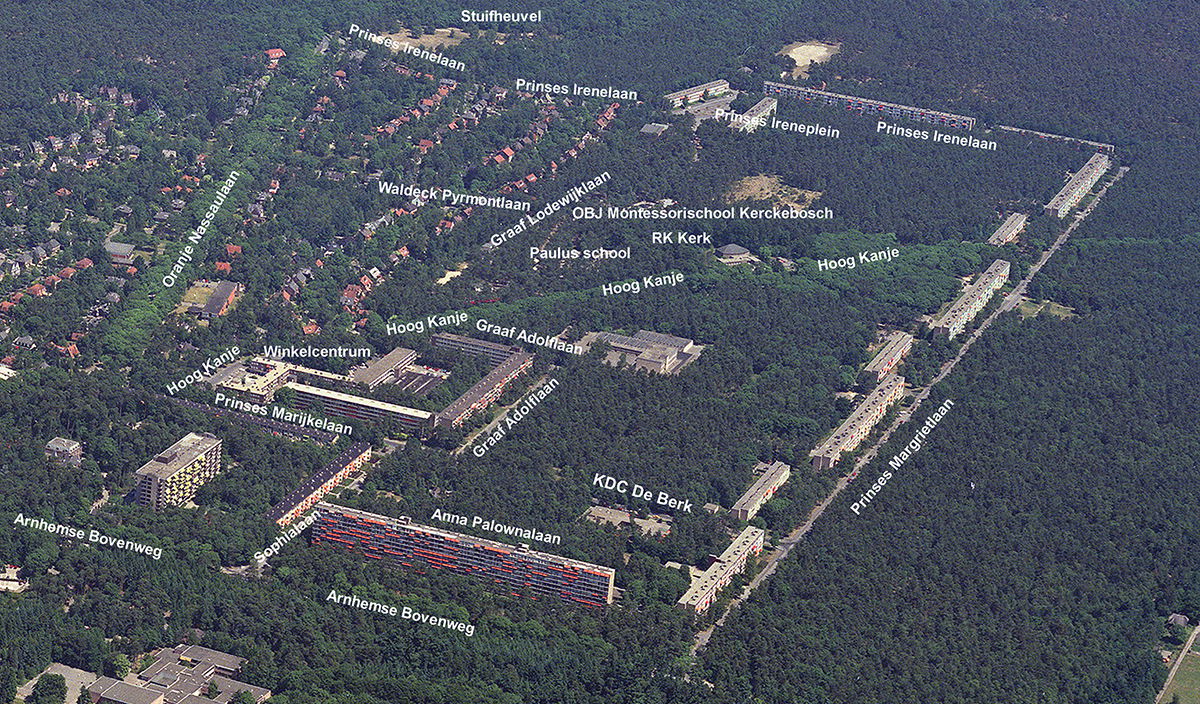
From 1920 onwards, the Kerckebosch on the Driebergseweg was divided into plots and thus the districts Kerckebosch and Hoge Dennen were created. The ponds of the Oranje Nassauplein were dug as part of the work provision scheme. The sand that was released was used to “throw up” the drift hill at the end of the Jagerssingel. The layout of the villa park made use of existing roads such as the forest road Hoog Kanje, the old Siberiëlaan (now Julianalaan) and the Jagersingel/Oranje Nassaulaan. The Oranje Nassaulaan was created in the early twenties during a caterpillar plague. To prevent the spread, a large strip of forest was cut down. Two squares were built on the wide avenue, the Oranje Nassauplein on the Kerckebosch and the Hoge Dennen side and the Julianaplein on the Hoge Dennen side. On the Kerckebosch estate, jhr. Louis de Geer (1911-2009), the father of television celebrity jhr. Ursul Philip de Geer (1946-2020), built Kerckebosch Castle from 1911. I knew his brother Floris, who was a car dealer and who passed away a few months ago, personally. I will write a separate story about this estate in the coming months.
Occupancy before 2009
Kerckebosch was living in the green next to the Hoge Dennen villa district and bordering the Zeisterbos and the Heidestein estate. Just after the Second World War, 11 gallery flats with over 750 flats were built in Kerckebosch on Prinses Margrietlaan and Prinses Irenelaan, this was 100% social housing. Approximately 2,350 people lived in the district. Flats with owner-occupied apartments were also built on Anna Paulownalaan, Sophialaan and a few owner-occupied and free rental flats on Prinses Marijkelaan, Graaf Adolflaan and the Hoog Kanje shopping centre. The aerial photo shows what the district looked like up to 15 years ago.

Construction of the new district and lighting
Apartments, terraced, patio, back-to-back, quadrant houses (block of four), care homes, beautiful detached and semi-detached villas were built in a mix of, among other things, free plots. These were built for the old and new residents of this diverse and lively new neighbourhood. Housing corporation Woongroen provides affordable housing for people on a tight budget and because the term social housing leaves its mark on the people who live there, I will continue to talk about Woongroen rent in my story.
The neighbourhood has approximately 3,120 residents compared to 2,350 before 2009 and consists of 55% Woongroen rent and 45% of private sector homes. The Kerckebosch neighbourhood consists of seven neighbourhoods between forest, heath and a park-like landscape that are directly connected to the Utrechtse Heuvelrug and Landgoed Heidestein with a harmonious transition from construction to nature. Each neighbourhood therefore has its own character and appearance and the neighbourhoods are separated from each other by forest, heath and park. The neighbourhoods are named Bosrand, Bij de Hoge Dennen, Op de Hei, Stuifduinen, De Hout, Bosgaarde and De Boswachterij.

Since 2012, Prinses Margrietlaan, Prinses Marijkelaan and Kerckeboschlaan have been illuminated at night by special LED lighting fixtures - which coincidentally but also very appropriately bear the name "Little Red Riding Hoods". When the designers of the district came up with this street lighting in 2012, they could not have imagined that in 2024 the wolf would be walking in the district under the "Little Red Riding Hoods" as a reality. The lighting above Kerckeboschlaan is energy-neutral and is supplied by the solar panels on the roof of the Christian Lyceum. The Little Red Riding Hoods dim automatically from 23:00 to 05:00. When the street lighting is switched on, light images of five animals that live in Kerckebosch are projected onto the ground at the beginning of the residential areas. Each animal is depicted in a circular projection with a different background color and pattern: 1. the “wolf” (how is that possible) can be seen at the beginning of Prinses Margrietlaan at the Anna Paulownalaan junction, 2. on Kerckeboschlaan at the Prinses Alexialaan junction the “owl”, 3. at the Prinses Catharina Amalialaan junction the “bat”, 4. at the Prinses Maximalaan junction the “sand lizard” (first spotted in the heathland on 01-10-2019) and 5. at the Prinses Mariannelaan junction the “fox”. Almost everyone I speak to knows nothing about the existence of these light images.
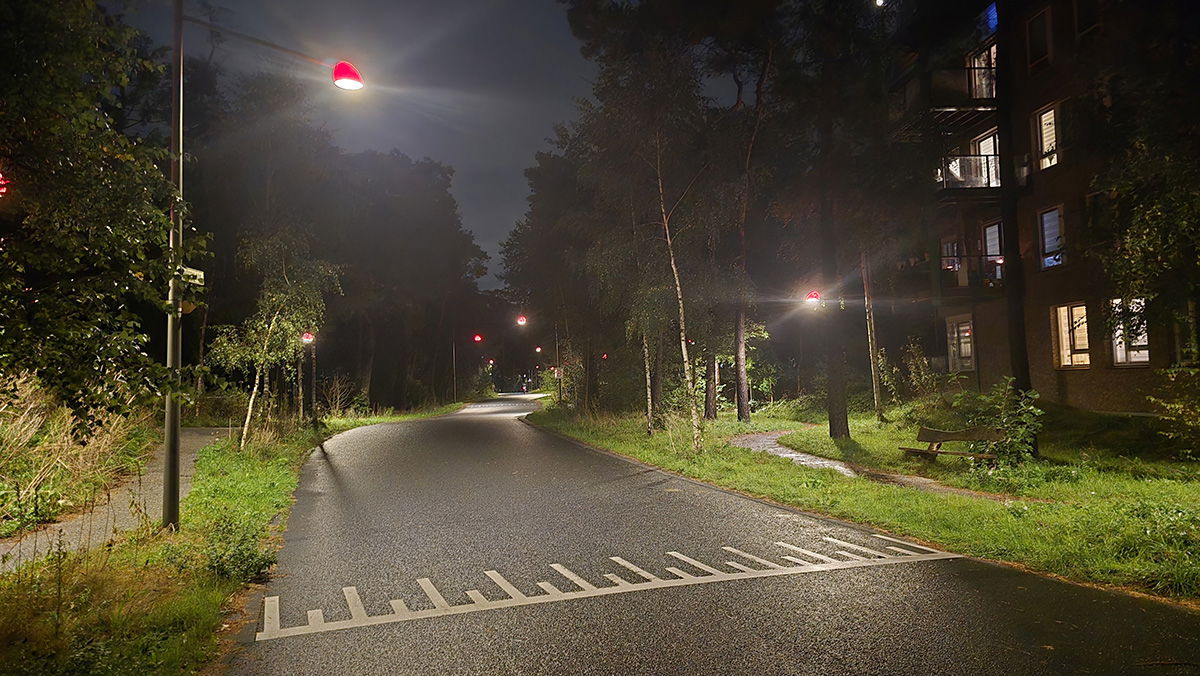
The speed limit in the entire district is 30 km per hour and 15 km per hour for schools, but few motorists, motorcycles, mopeds, fat bikes and speed pedelecs seem to be bothered by that. According to many, it is waiting for the big blow because residents themselves but also suppliers drive much too fast on narrow and winding roads with sharp bends in which the oncoming traffic cannot be seen. Every day we see that in front of our apartment with daycare center (15 km per hour) also in the dark with and without lights, people drive much too fast and often faster than 60/80 km per hour.
When we moved to the Kerckebosch district in April 2022, the dogs could still run around in the forest because it was one big off-leash area and we walked towards Austerlitz every day. Since the beginning of 2023, the wolf has been prowling here and has already killed about 10 sheep, deer have moved on and a leash requirement applies from the Bosgaarde neighborhood towards Austerlitz. Since 1975, all our dogs have been off-leash here, first with our English blue roan Cocker Spaniel Joep, then English blue roan Cocker Spaniels and brothers Charlie & Chaplin, later German Wirehaired Pointer Claire, then German Shorthaired Pointer Joy, later still our Bracco Italiano Luna and now with Siena & Giulia who are suddenly no longer allowed to run free. We and all other dog owners in the Kerckebosch district find this very unfortunate and annoying.

Start walk
But we are going to start our walk and before leaving, but now in front of our apartment in the Lucht building up there on the corner, I take a picture of Siena & Giulia. Look at them sitting there in the sun and bright air. It is wonderful here. We first walk through the forest to the beginning of the Prinses Margrietlaan on the Arnhemse Bovenweg to walk from there through the Kerckebosch district.
Prinses Margrietlaan (built 1962, renovated 2020) neighborhood “De Boswachterij” light image the “wolf” 75 addresses and 165 inhabitants Named on January 6, 1958 after Margriet Francisca (1943), Princess of the Netherlands, Princess of Orange Nassau and third daughter of Queen Juliana and Prince Bernhard. Married to Mr. Pieter van Vollenhoven.

In the Prinses Margrietlaan, opposite the Heidestein estate, lies the Woongroen rental apartment building Zwaluwnest (the old Geroflat/flat 11). It is the only one of the 11 gallery flats that remained standing after the demolition and has been thoroughly renovated. Just look at how contemporary and well-kept it looks. The other 10 flats with 706 flats have been replaced by 1,100 homes in 10 beautiful apartment buildings with about 15 rows of houses and are spread throughout the entire Kerckebosch district. Many people in the Netherlands would like to live like this.
Wijkinloophuis Kerckebosch
In the Zwaluwnest at Prinses Margrietlaan 32, on the ground floor to the right of the main entrance, is the Wijkinloophuis. It is an organisation of, for and by residents of the Zeist-Oost district. A place in the district where people can meet, where support is available and where people help local residents who could use some help. Everyone is very welcome. Here you can come for a chat and a cup of coffee or tea and you can participate in one of the activities. If you have a question for help, or if you want to use a free facility, please visit www.wijkinloophuiskerckebosch.nl
Continuing to walk towards Prinses Marijkelaan, on the corner is the nine-storey apartment building called “Beaufort”. The penthouse has balconies all around and the residents allowed me to take photos of the district from the ninth floor. A beautiful 360 degree view over Zeist, towards Austerlitz, Veenendaal, Driebergen, Odijk, Utrecht, De Bilt and Soesterberg. In the distance you can even see the Dom of Utrecht if you look closely and what beautiful cloud formations. From up here you can see how green Zeist is, but you also only see the buildings that protrude above the trees or are located in open areas such as heathlands.

Prinses Marijkelaan (built 1960-2024) neighborhood “De Boswachterij” 390 addresses and 525 inhabitants
Named on January 6, 1958 after Maria Christina (1947-2019), Princess of the Netherlands, Princess of Orange Nassau and fourth daughter of Queen Juliana and Prince Bernhard. Former nickname Marijke.
The tall and beautiful apartment building Beaufort was completed in 2024. This beacon of the neighborhood with the themes sand-trunk-leaf are stacked in this building. The theme “sand” is reflected in the sand ribs of the parapet around the outwardly folded balconies, the theme “leaf” is incorporated in the undersides of the exterior ceilings with a green ribbed needle profile and the profiled wooden facade cladding is the theme “trunk”. Next to Beaufort are the free rental apartment buildings “Light & Air” (construction 2022). Light is airy, Air is light and with windows from floor to ceiling it provides a lot of light and air. The apartments have HR+++ (triple) glazing, 4 solar panels, are off the gas and have individual heat pumps that are connected to a “collective” ground heat exchanger with boiler. In winter, heat and in summer coolness is extracted from the ground under the apartments. So underfloor heating and floor cooling. The apartments are also individually connected to a closed ventilation system with heat exchanger that cleans dirty and humid air and returns it clean. All this means that we have an average monthly energy consumption of €12,=. In August even only €2.06, yes you read that right and tell me who wouldn't want that?
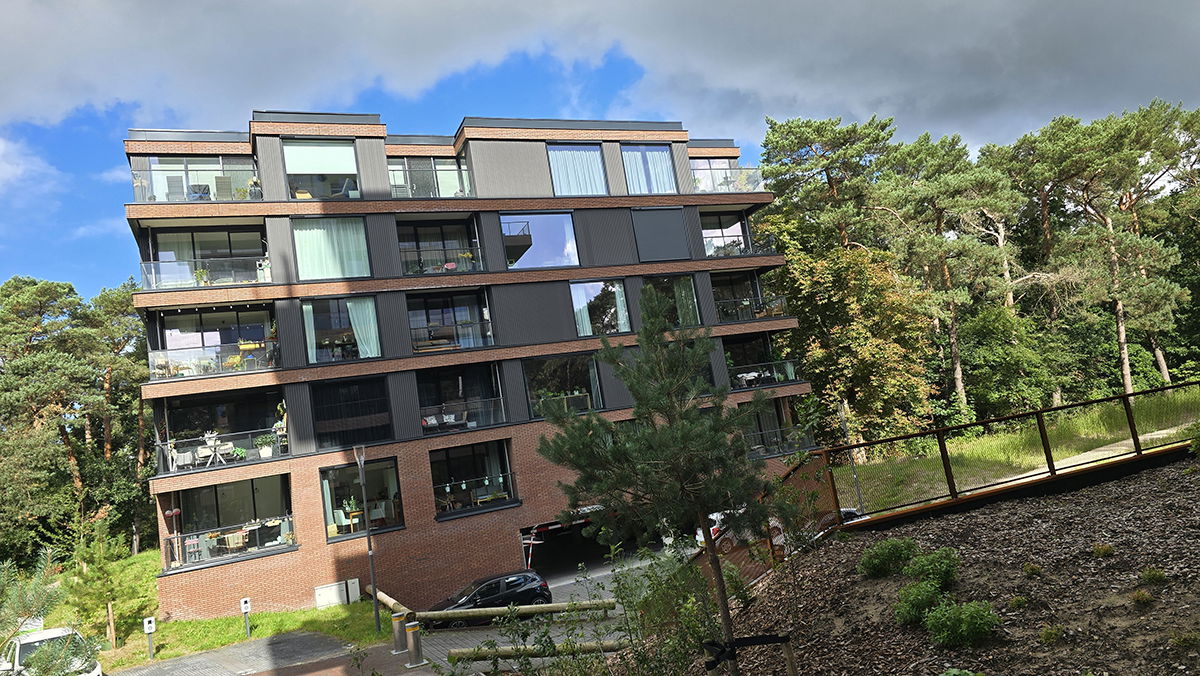
Kerckebosch onder water
Rainwater from roofs and terraces is not dumped into the sewer but is collected and led to the nearby wadis. Wadis (Water Drainage and Infiltration) are storage and infiltration facilities that are temporarily filled with rainwater. The downside of draining rainwater in this way is - because from October 2023 to the end of August 2024, 350 mm more rain fell in Zeist than normal - that parking garages and basement storage areas in the entire Kerckebosch district were flooded from December 2023 to June this year. For months, enormous diesel generators and electric pumps were pumping up the water to drain it via hoses tens of meters long to sewer wells. In my mind I can still hear those diesel generators and pumps humming everywhere. Long live nitrogen and diesel smell/noise under your apartment 24 hours a day. According to the municipality, no measures can be taken to lower the groundwater level, but owners must ensure that basements and parking garages are waterproofed themselves. Apparently, rainwater drainage has not been properly considered and I expect this to become a regular event in the future.
Kinderdagcentrum de Berk
Opposite the Lucht building is Reinaerde Kinderdagcentrum De Berk with after-school care and Saturday care for 50-60 children up to the age of 12 with developmental delays, multiple or intellectual disabilities. They are lovingly welcomed and cared for by over 20 caregivers and the children are brought daily by parents, taxis and vans at 9:00 am and taken home again until 6:00 pm.

Next to the Lucht building is the beautiful Woongroen rental apartment building called “Merelnest” (built in 2015) and directly opposite is a street with Woongroen homes with the same type of homes on the left and right at the end. They are also located on Prinses Marijkelaan. Prinses Marijkelaan is a long road but strangely enough it also has 5 side and back streets numbered 84-132 and 42-48 with a mix of rows of Woongroen rental and owner-occupied homes. These addresses are difficult for visitors and suppliers to find and you often see cars driving back and forth before the right address is found. Next to the Merelnest, the Kerckeboschlaan starts with the magnificent looking apartment building “Koekoeksnest” (built in 2015) on the corner of which I recently heard that it is not for sale but Woongroen rental. Prinses Marijkelaan continues on the other side past the Koekoeksnest with an immediate right-angled bend to the right (to the Graaf Adolflaan) and immediately to the left again until the road Hoog Kanje.
Kerckeboschlaan 38 addresses and 110 residents
On 15 February 2012, the central access road to the Kerckebosch district was given the name Kerckeboschlaan.

The Kerckeboschlaan meanders 900 meters long as the main access road through our wooded district to the various neighborhoods. The avenue is lined with terraced houses, you pass the Seyster College, a number of detached houses, a courtyard with slate roof houses at the height of Prinses Maximalaan and ends just past the houses and apartments opposite the Prinses Mariannelaan with the light image of the “fox”.
I continue my way on the Kerckeboschlaan on a meandering footpath between forest and trees and walk a hundred meters further on at the T-junction the
Prinses Alexialaan in (construction 2010-2024) neighborhood “Bosgaarde” with light image the “owl” 158 addresses and 370 inhabitants
On February 15, 2012 named after Alexia Juliana Marcela Laurentien, Princess of the Netherlands, Princess of Orange-Nassau (2005) middle daughter of King Willem-Alexander and Queen Máxima.

In this neighborhood there are two beautiful Woongroen rental apartment buildings called “Heidehof” at the front right on the corner with further on against the edge of the forest “Boshof”. What surprises me, but annoys me even more, is that plastic ivy has been applied to the outer walls of the Boshof building. How is it possible that in a neighbourhood where living in nature is the driving force behind the design, a “Woongroen” corporation finds it in its grey/green brain cells to apply PLASTIC ivy to the outer walls of a building. SHAME! and REMOVE immediately! On the left and right is a mix of rows of Woongroen rental and owner-occupied houses. At the front left is a neighbourhood library in front of a house like you see in many streets these days. On the left behind the rows of houses and against the edge of the forest are another 50 back-to-back houses without a garden but with a place. In Kerckebosch, the forest and heath are the garden and the back back-to-back houses are 10 metres from the edge of the forest Heidestein with a garden that is kilometres long. A few weeks ago, the wolf walked past the house of an acquaintance. His colleagues in Amsterdam, when they heard that, shouted great and how nice. Yes, they live safely in the city and would howl differently here.
Between the houses I walk to the
Prinses Arianelaan (built 2010-2023) neighborhood “De Hout” 150 addresses and 315 inhabitants
On February 15, 2012 named after Ariane Wilhelmina Máxima Ines, Princess of the Netherlands, Princess of Orange-Nassau (2007) youngest daughter of King Willem-Alexander and Queen Máxima.
On the corner is the owner-occupied apartment building “Eikenveste” with next to it the Woongroen apartment buildings Lindeveste, Dennenveste and Berkenveste. Each and every one of them is a magnificent building and what a variety of homes you see here again. There is no uniformity here like all those post-war neighborhoods in the Netherlands. Houses with beautiful overhangs and high roofs. In this neighborhood there are 18 Dudok semi-detached houses, detached villas and patio houses.
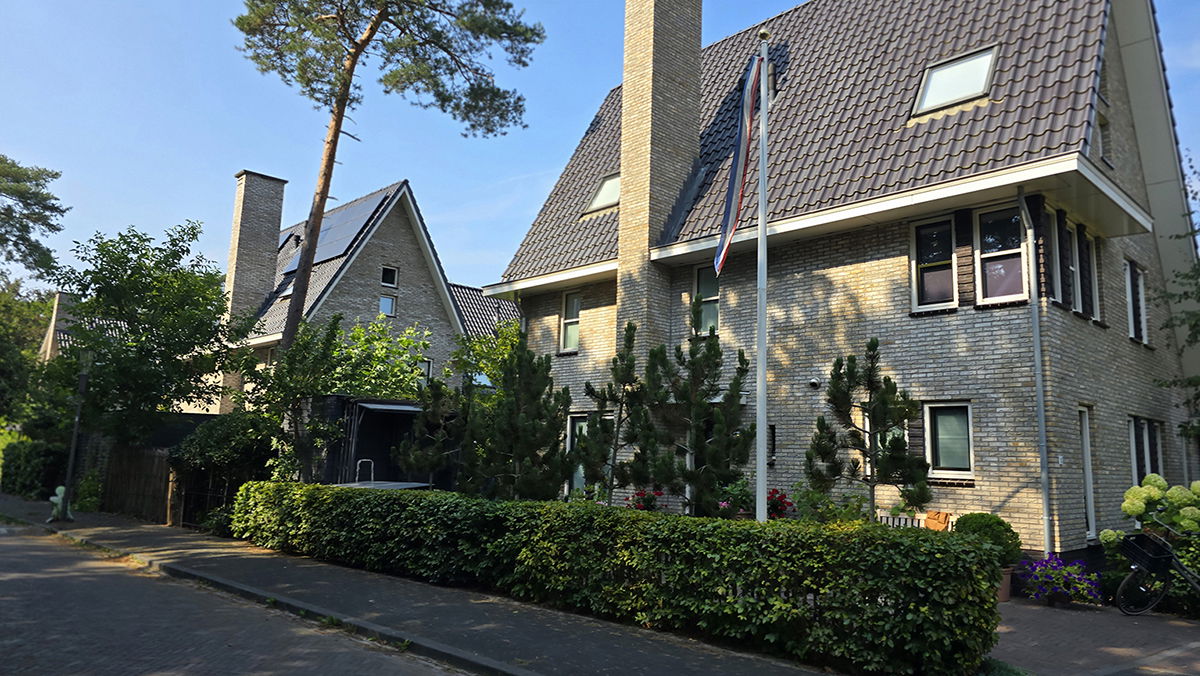
Further along the edge of the forest are 2 detached, 8 semi-detached and 4 terraced houses that look like colossal wooden villa boxes in a neighborhood called “Elix” within the “De Hout” district. I read that the residents had to write a kind of application letter or “motivation” for these houses to indicate why they wanted to live in “Elix”. So it can be even crazier to be eligible for a house that had to cost between approximately €500,000 and €1,100,000 when sold in 2019. Pioneers who find it important to live sustainably and inclusively (do they mean exclusively?). The residents share a love of nature, but don’t we all? I am looked at suspiciously when I walk between the houses with my dogs on a leash (private property!).

I continue my way and cross Hoog Kanje and first pass the house donated by the Wijkontwikkelingsmaatschappij (WOM) to the Utrechts Landschap, which contains materials with which “naartuurburen” (volunteers) from the Kerckebosch district maintain the forest areas (dikes) in the various neighbourhoods once a month under the guidance and on behalf of the Utrechts Landschap. The Hoog Kanje road cuts through the Kerckeboschlaan and runs left towards schools, the Binnenbos and the shopping centre. Turning right, you walk to the Heidestein estate and towards Austerliz. But we walk straight ahead on the Kerckeboschlaan and I immediately see the
Prinsessenhof (construction 2020) neighbourhood “Stuifduinen”, 10 addresses and 25 residents on my right.
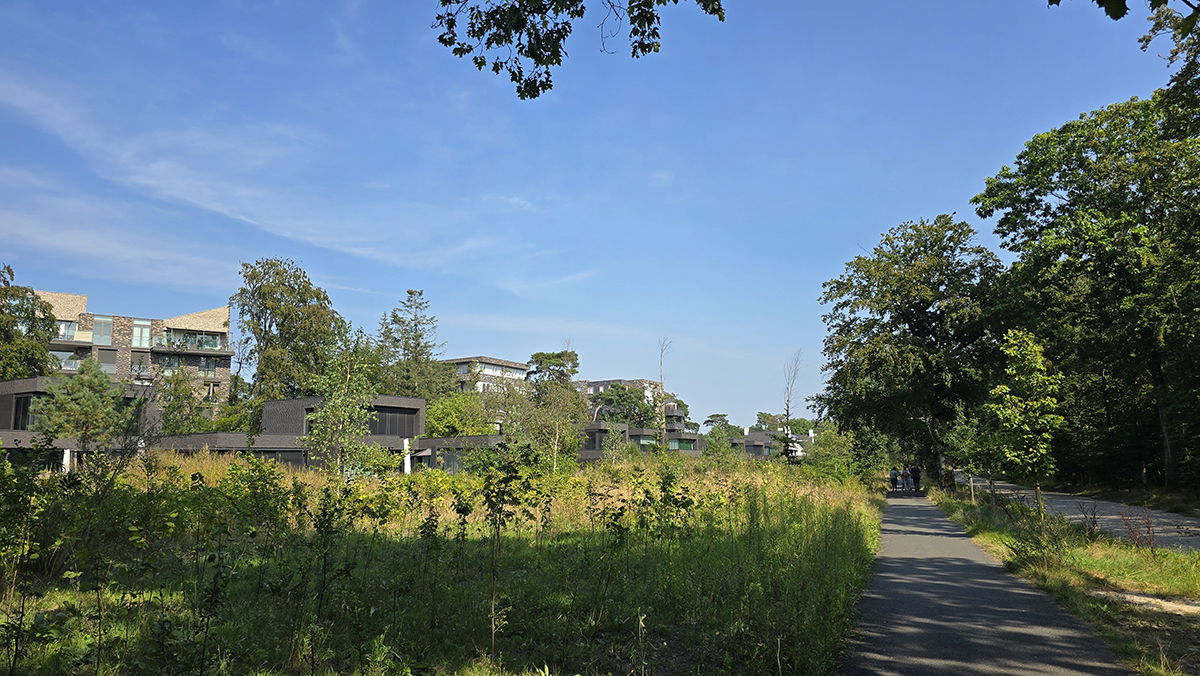
This court can only be reached by car via the Prinses Catharina Amalialaan. Looking out over the old sand road Hoog Kanje, the ten linked villas look magnificent, but from the other side the houses are less free on a narrow road close to the apartment buildings on Prinses Catharina Amalialaan.
We walk on to the
Prinses Catharina Amalialaan (construction 2015-2018) neighborhood “Stuifduinen” with light image the “bat” 200 addresses and 550 inhabitants
Named on February 15, 2012 after Catharina-Amalia Beatrix Carmen Victoria, Princess of Orange, Princess of the Netherlands, Princess of Orange-Nassau (2003) eldest daughter of King Willem-Alexander of the Netherlands and Queen Máxima.

On the corner is the purchase apartment building “Dassenburg” with the Woongroen apartment buildings “Beverburg and Vossenburg” next to it. What beautiful buildings these are again. There are also many beautiful houses in this neighborhood that I walk between. What surprises me is that no one in the entire Kerckebosch district asks why I photograph schools, houses and apartment buildings etc. Only at the Christian Lyceum did the caretaker run after me to ask why I was photographing the school. After I introduced myself and explained that I was taking photos of all the avenues and buildings for a presentation in the “Binnenbos” during Neighborhood Day 2024 and the festive conclusion of 15 years of building Kerckebos and not capturing people and certainly not children, he was reassured. He was really the only one who spoke to me when I took about 600 photos throughout the entire district. Incidentally, I also do not photograph legible license plates. Everywhere people greeted me back and admired my dogs, but of course there were also those who walked around us in a wide arc. It could also be that I was exploring the neighborhood and that these were my future burglary addresses. This just goes to show that if you pretend you belong somewhere, you can get away with it.
Across the heath between Prinses Catharina Amalialaan and Prinses Maximalaan I walk to the
Prinses Maximalaan (construction 2015-2018) neighborhood “Op de Hei” with light image “the sand lizard” 60 addresses and 195 inhabitants
Named on February 15, 2012 after Máxima, Princess of the Netherlands, Princess of Orange-Nassau, Mrs. van Amsberg (1971), born as Máxima Zorreguieta Cerruti. and wife of King Willem-Alexander of the Netherlands.
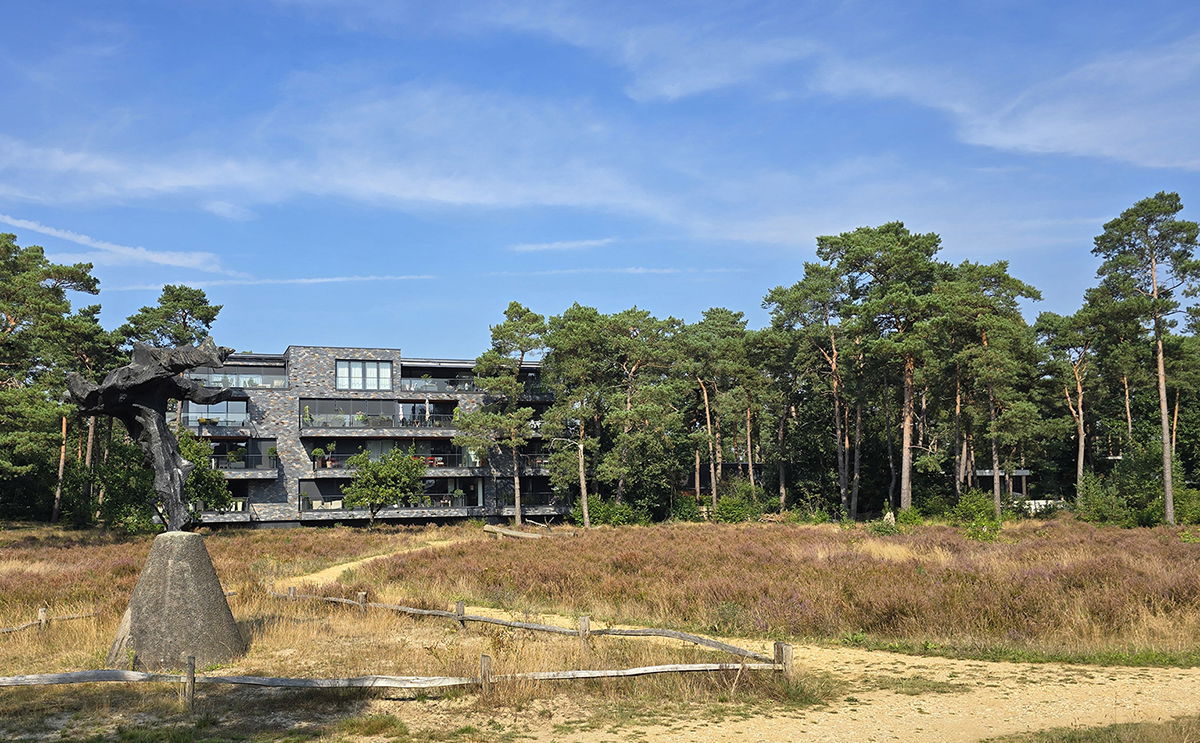
On the heath and at the beginning of the avenue lies the apartment building “De Leihorst” built, as the name suggests, from slate and with enormous terraces overlooking the heath. A fantastically beautiful place, and you notice in comparison with the buildings at the beginning of Kerckeboschlaan, that the neighborhoods gradually have fewer addresses but with larger houses built on more land and are more expensive. You no longer see terraced houses here but detached and semi-detached villas in all shapes and sizes. Beautiful, but I am so happy with our comfortable and compact apartment. No maintenance on house and garden, no property tax, no worries about burglary and the like, close the front door and get out of here. No, buying houses are a thing of the past for us. Unfortunately, the flock of sheep, which grazes the heathlands in Kerckebosch twice a year and consisted of a mix of Veluwe and Drenthe heath sheep, suddenly became extinct due to bluetongue, but Bor de Wolf had also bitten the throats of ten of them.
I walk through the district all the way to the end and through the forest I arrive at the heath behind the
Prinses Mariannelaan (built 1952-2020) neighborhood "De Bosrand" with light image the "fox" 15 addresses and 55 inhabitants
Named on February 15, 2012 after Wilhelmina Frederica Louisa Charlotte Marianne (1810-1883), Princess of the Netherlands, Princess of Orange-Nassau daughter of King William I of the Netherlands and Princess Wilhelmina of Prussia.

Here is another lane with a row of four white houses and a detached house where an old 'ugly duck' is parked under a rickety carport. Next to this was a sports field along which we used to walk from the drift hill towards the sheepfold.
In this neighborhood there used to be three flats of the Prinses Irenelaan. The first thing you notice when you walk up here is the enormous house that was built in the old style and looks out over the heath. There are also a number of cottages here, each one more beautiful and special than the other and no two are the same. We walk through the lane towards Kerckeboschlaan past a house with a saddle roof. In terms of space division it doesn't seem advantageous to me but it is special.
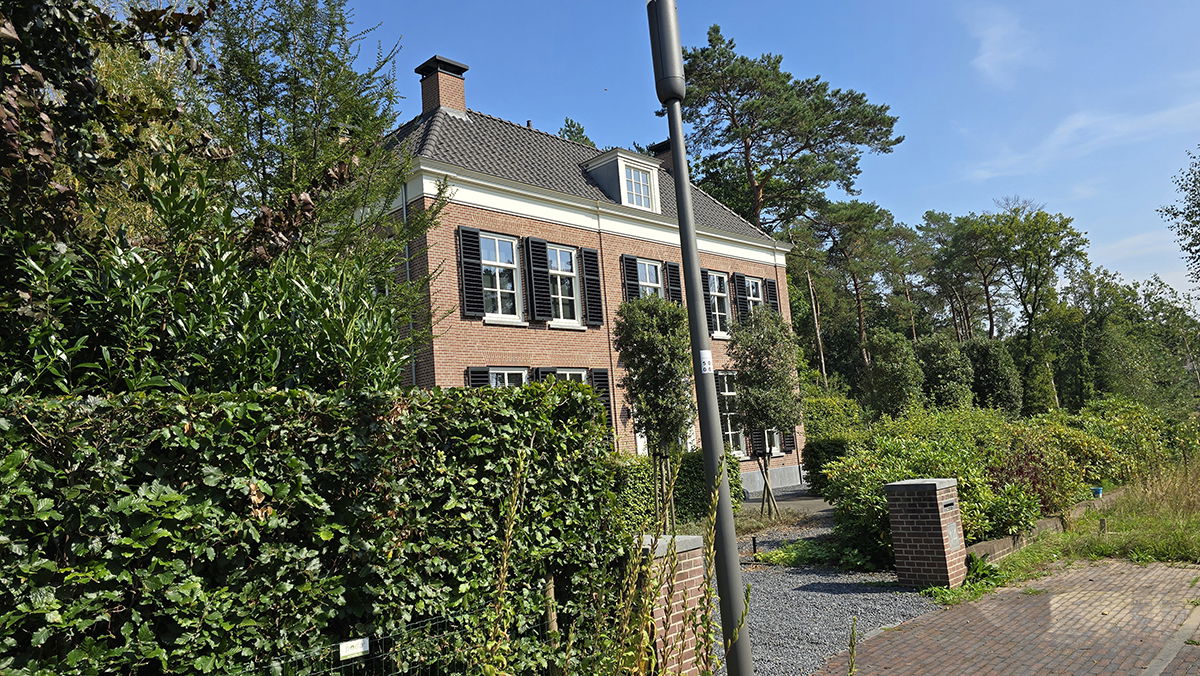
At the end of Prinses Mariannelaan you can turn right onto Prinses Irenelaan towards Stuifheuvel but we turn left onto Kerckeboschlaan and walk past apartments and houses that were completed over a year ago and apparently have so much water damage in the underground parking garage that workers have been working on making it waterproof for months.
Then follows a courtyard, with I estimate about ten slate houses and where there is a threatening no entry sign and a private road. So we continue walking to the
Graaf Lodewijklaan (construction 2010-2020) neighborhood “Bij de Hoge Dennen” 22 addresses of which 19 residential addresses and 80inhabitants
On 6 January 1958 named after Lodewijk, Count of Nassau (1538 – 1574), brother of Prince William I of Orange. He was one of the main initiators of the League of Nobles. Fought against the King of Spain. He was killed on 14 April 1574, together with his brother Hendrik, in the battle on the Mookerheide.
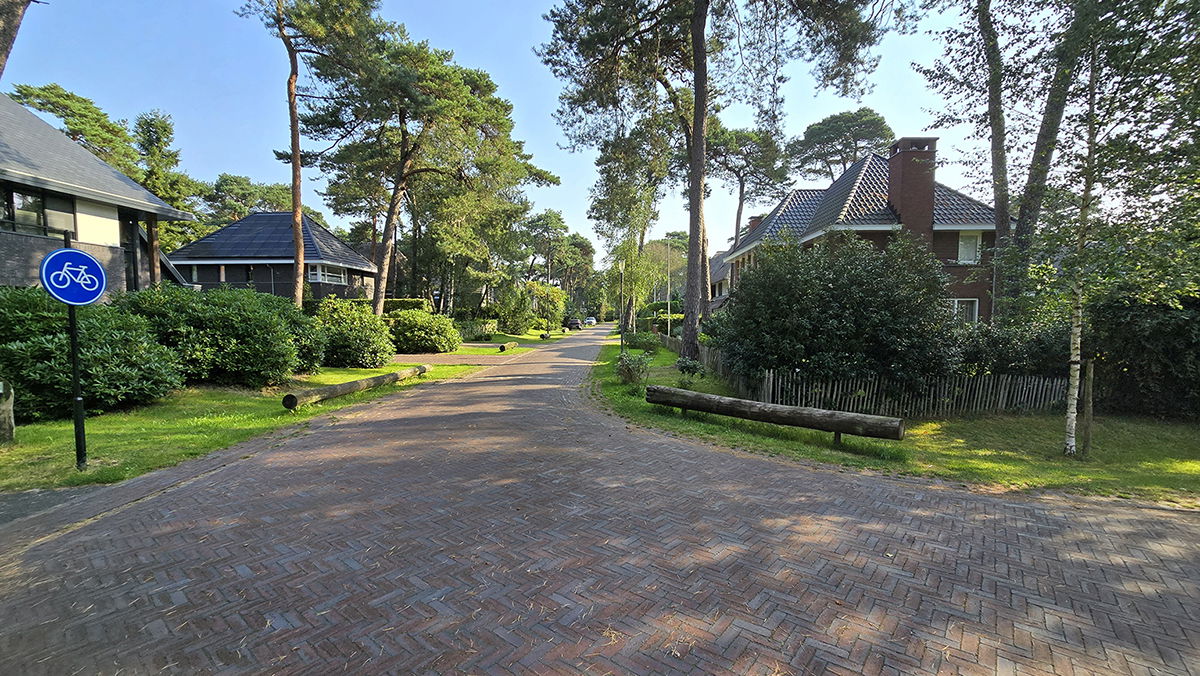
It is a dead-end lane with detached houses which I personally find the most beautiful lane in the Kerckebosch district and, if you look up the prices of the houses, you can call this the “Gold Coast” of the Kerckebosch district.
At the end you can cycle or walk to the schools located near Hoog Kanje, such as the Brede School Kerckebosch (2017) with two primary schools, the Damiaanschool, the Wereldkidz Motessorischool and childcare Kind & Co and separately there is also “De Stuifheuvel” School for Special Primary Education.
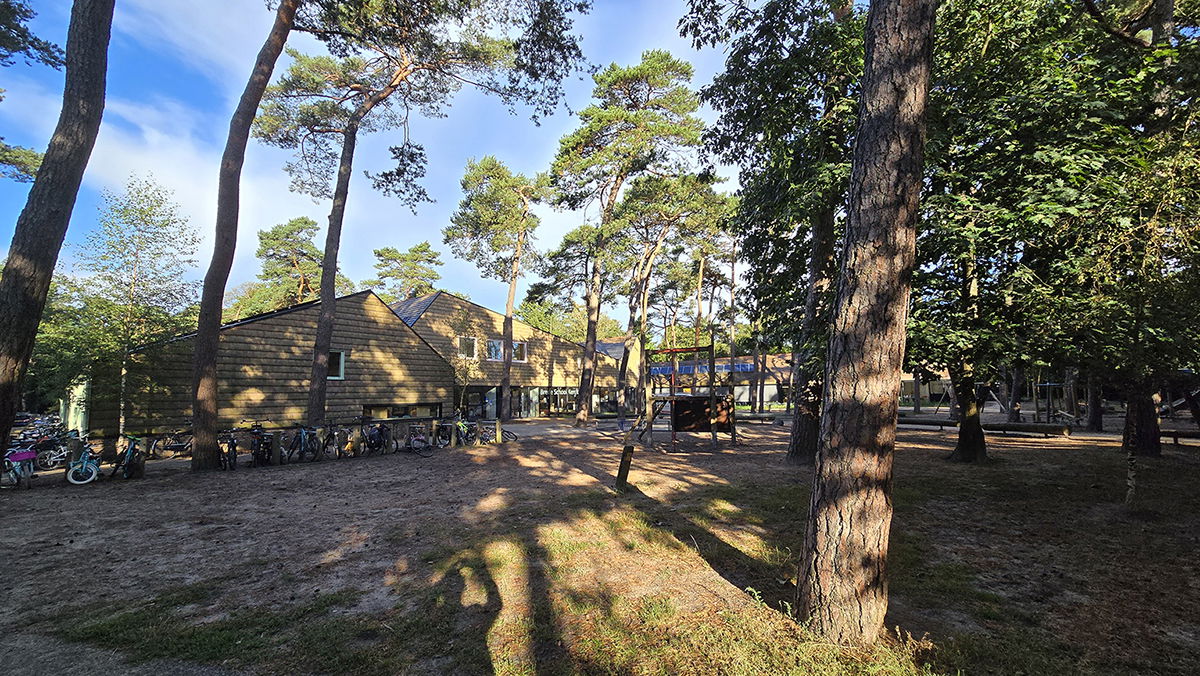
Halfway along, the Graaf Lodewijklaan is crossed by the Waldeck Pyrmontlaan. This is partly located in the Kerckebosch district but also in the Hoge Dennen district.
We walk to the part that is located in the Kerckebosch district.
Waldeck Pyrmontlaan (construction 2010-2020) neighborhood “Bij de Hoge Dennen” 2 addresses and 9 inhabitants.
Named on June 22, 1933 after the principality of Waldeck and Pyrmont, the ancestral land of Queen Emma, daughter of George Victor, Prince of Waldeck and Pyrmont and Helena, Princess of Nassau.

In this street there are 2 new houses, number 8 of which is hardly noticeable behind trees and bushes.
We walk on to
Hoog Kanje (built 1920-2020) 236 addresses of which 195 residential addresses and 240 residents
The name Hoog Kanje was officially established by the municipal council on 18 November 1920. The name Hoog Kanje is first mentioned in a deed of transfer dated 22 April 1784. The property mentioned in this deed was located between the Driebergseweg and the Arnhemse Bovenweg and was bordered to the northwest by Heerewegen and to the southeast by the Breul. The name Hoog Kanje probably has a French origin. The meaning can be thought of as the well-known French family name Du Cange, as well as the city of Cagnes in the south of France.
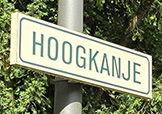
The first thing that strikes me is that the name Hoog Kanje is written together on all street name signs, while there should be a space between them. Someone has clearly been asleep during production and inspection. Hoog Kanje is the most important street in the Kerckebosch district, but the first part with 19 addresses from the Oranje Nassaulaan just past the Graaf Janlaan, is located in the Hoge Dennen district.
Binnenbos
In the middle of the district (in the old Binnenbos) lies the Multifunctional accommodation “Binnenbos” which is the meeting place for the Kerckebosch Zeist-Oost district. The building houses a district service point, general practitioners, a pharmacy, physiotherapy practice, speech therapist, skin care, Mensendieck, beauty practice, a music school and gymnasiums. The sports halls are there for the schools and after school for the district and associations. In the homes on the 1st and 2nd floors, 42 clients of Abrona have their home.

The Binnenbos is also the location of the Golden Carriage of the “Stichting Vrienden van het Binnenbos”. Independent elderly people in the Kerckebosch and Hoge Dennen districts who have difficulty walking can use the “Golden Coach” free of charge. We pick them up for a visit to the Binnenbos, doctor or pharmacy, supermarket or a visit to a friend in the district and also bring them home again.
On the Hoog Kanje road you will find the shopping centre and beyond the Binnenbos there are also Huize Hoog Kerckebosch (small-scale care home for elderly people with dementia or physical disabilities), Woonzorg Kwintes (supported and sheltered housing), Het Kraaiennest After-school care and the Seyster College School for practical education.
Before we go home, we quickly walk through a few streets with old buildings.
Graaf Adolflaan (built in 1961) neighborhood “Boswachterij” 135 addresses and 215 residents
Named on January 6, 1958 after Adolf, Count of Nassau (1540-1568), younger brother of Prince William I of Orange. He was killed on May 23, 1568 at Heiligerlee.
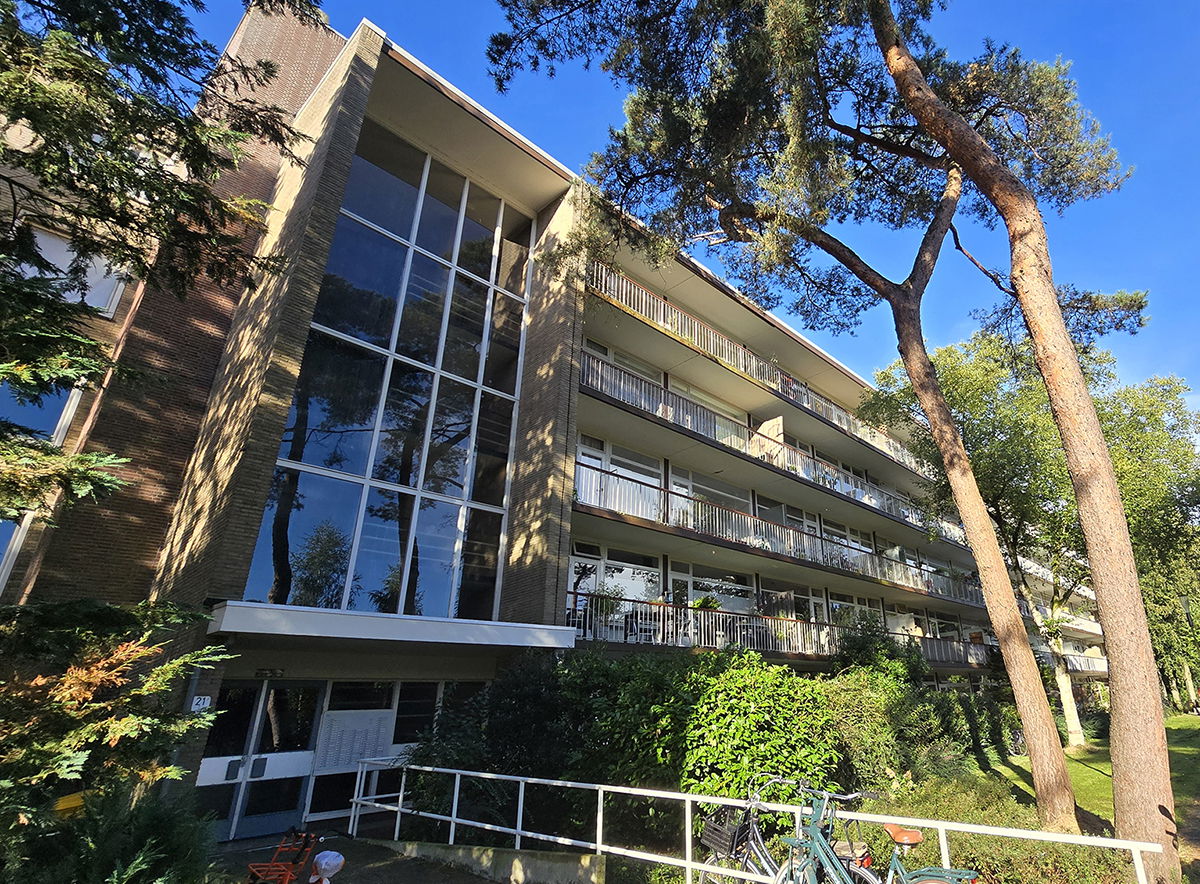
This semi-detached apartment building with a mix of purchase and free rental has an entrance on the short section and on the long section. Rental properties that become available are sold. Opposite the short section is the Christian College Zeist (Preparatory Secondary Vocational Education).
Then back to the Prinses Marijkelaan where there is a third entrance that provides access to the purchase apartment section that was completely renovated in 2022. Towards the shopping center, on the left of the avenue and hidden behind bushes and trees, you have 20 purchase apartments (without a name), which look exactly the same as on the Sophialaan.
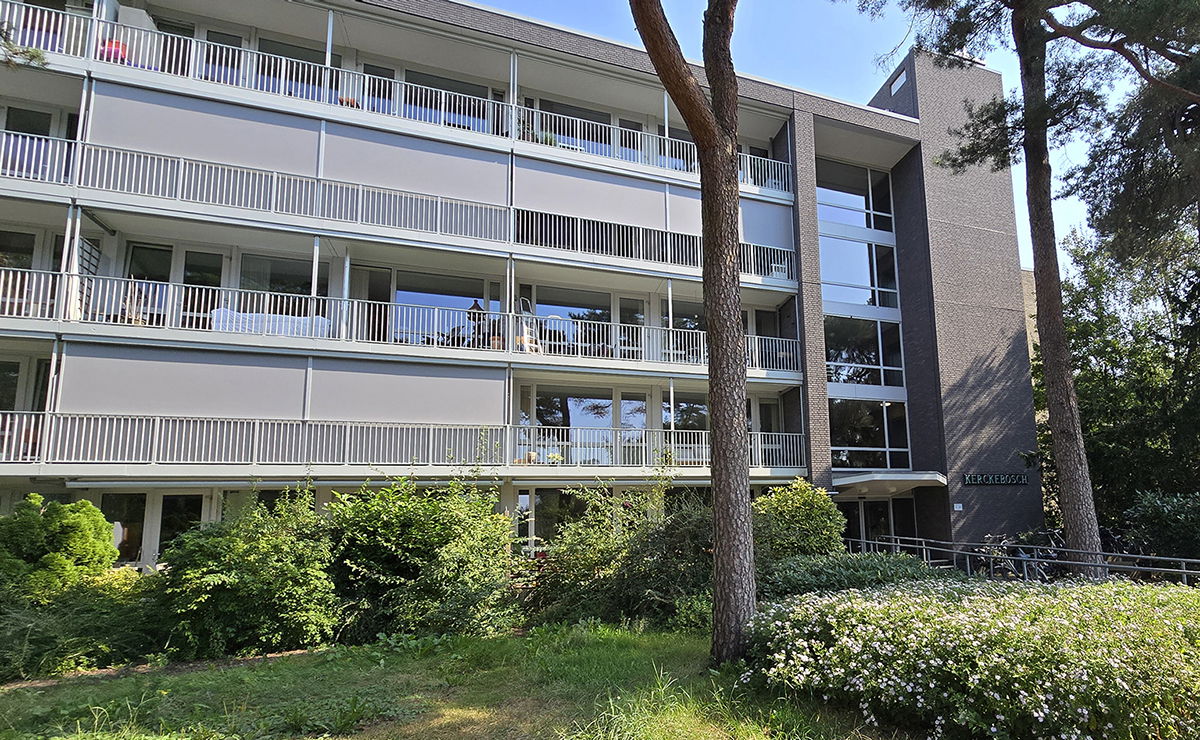
We walk opposite the entrance of the “Kerckebosch” apartment building to the
Sophialaan (built 1932-1960) neighborhood “De Boswachterij” 55 addresses and 95 inhabitants
Named on January 6, 1958 after Sophia Frederica Mathilda (1818 – 1877), Queen of the Netherlands, Princess of Würtemberg. She married her cousin, the later King Willem III.
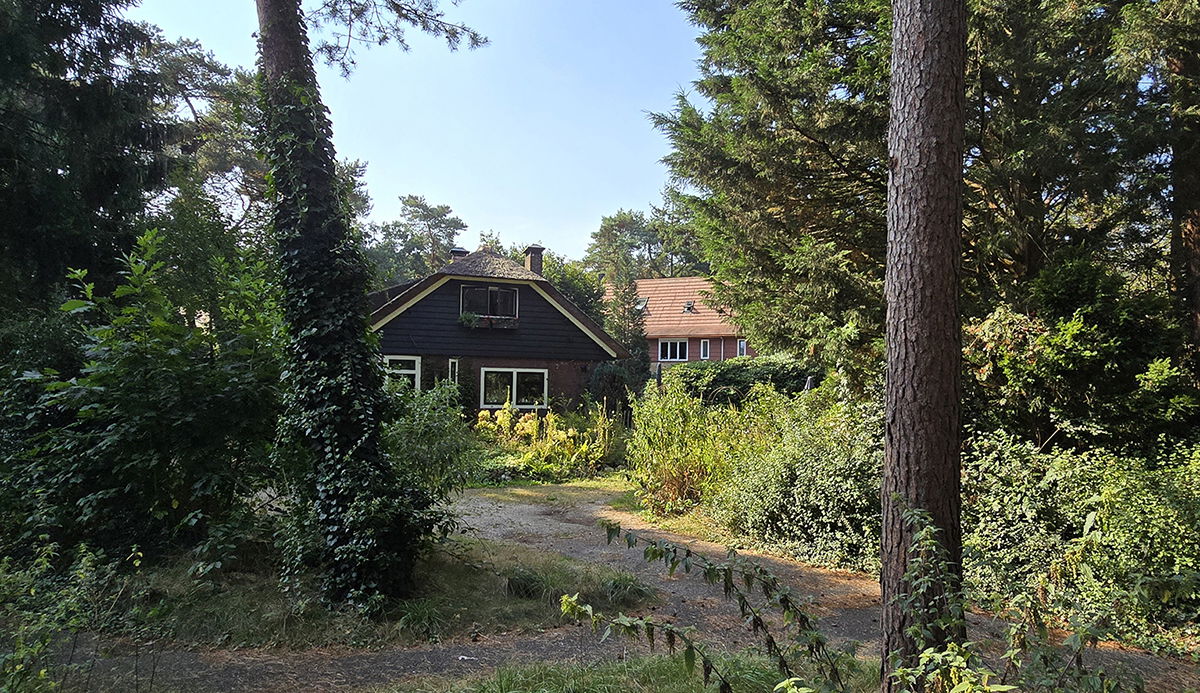
Hidden behind the trees here is the old forester's house from 1932 where a young family now lives and where the stork landed in 2023.
At the end of this old lane you will come out on the Arnhemse Bovenweg again, but just before that we turn left and walk through the
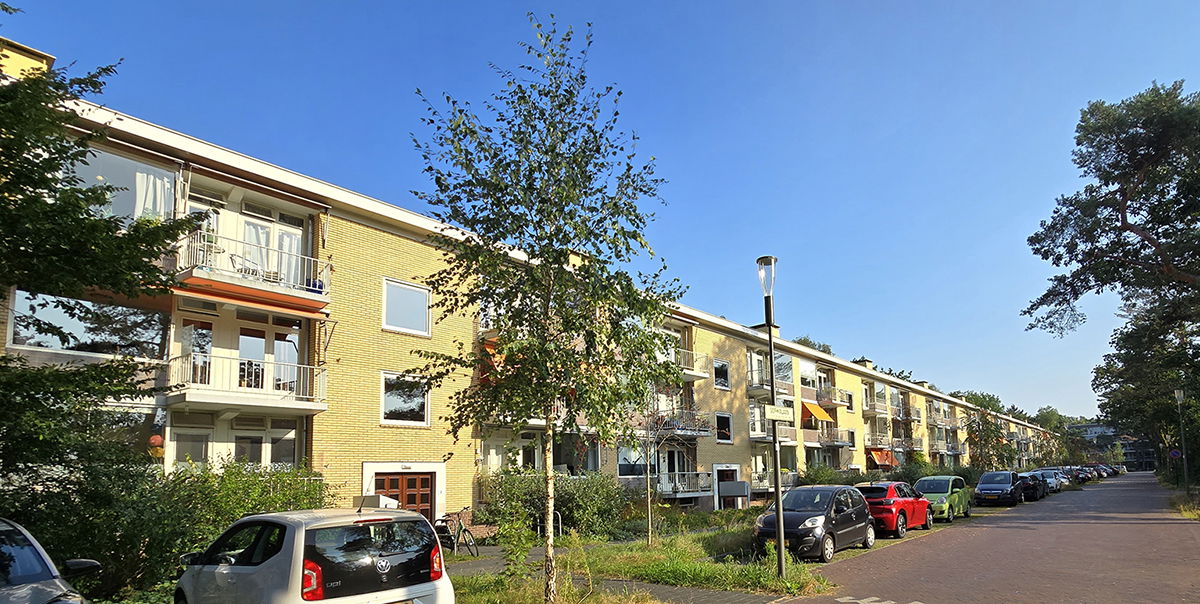
Anna Paulownalaan (built in 1965) neighborhood “De Boswachterij” 200 addresses 315 inhabitants
Named on 6 January 1958 after Anna Paulowna (1795-1865), Queen of the Netherlands, Grand Duchess of Russia, daughter of Paul I, Emperor of Russia and Maria Fedorowna, Princess of Würt emberg. She married the later King Willem II in 1816, upon whose accession to the throne she became Queen.
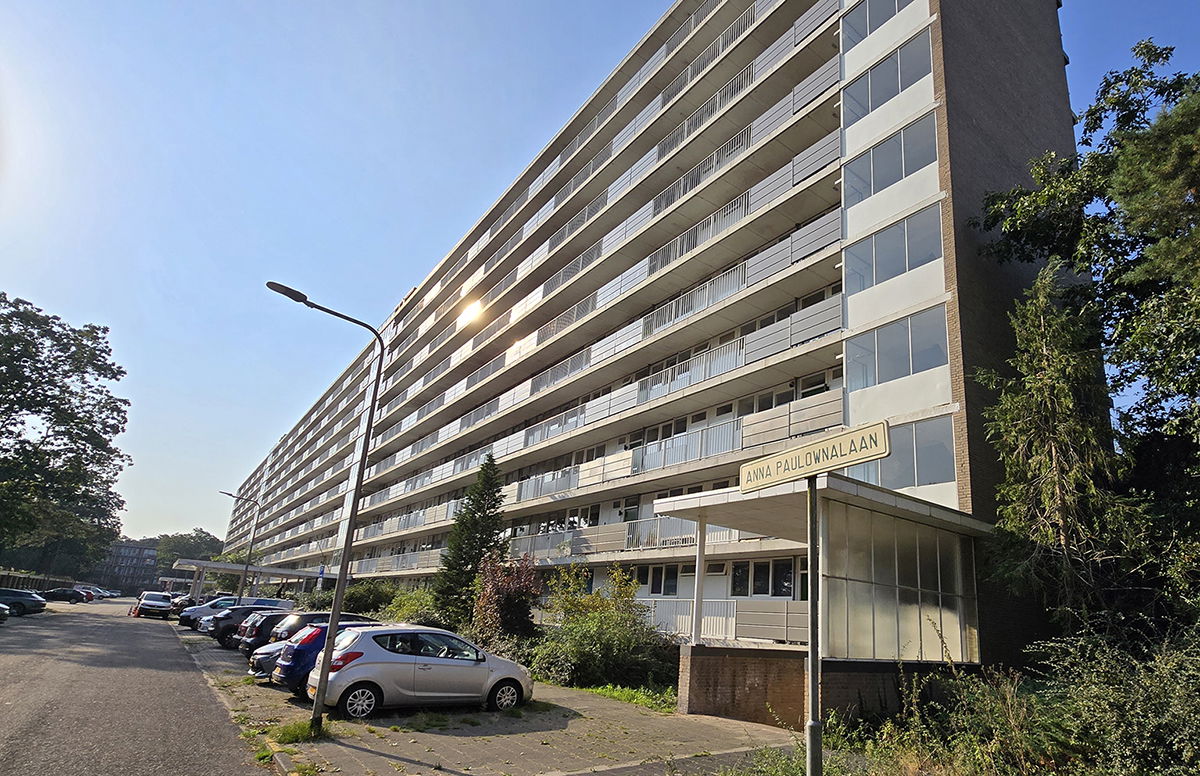
This colossal apartment building houses 200 apartments and looks like De Geroflat on the Laan van Vollenhove where we got our first home 44 years ago. Unbelievable how long and high. Fortunately, they don't build flats like that anymore these days. I am now back at the beginning where our walk started and I hope you enjoyed it.
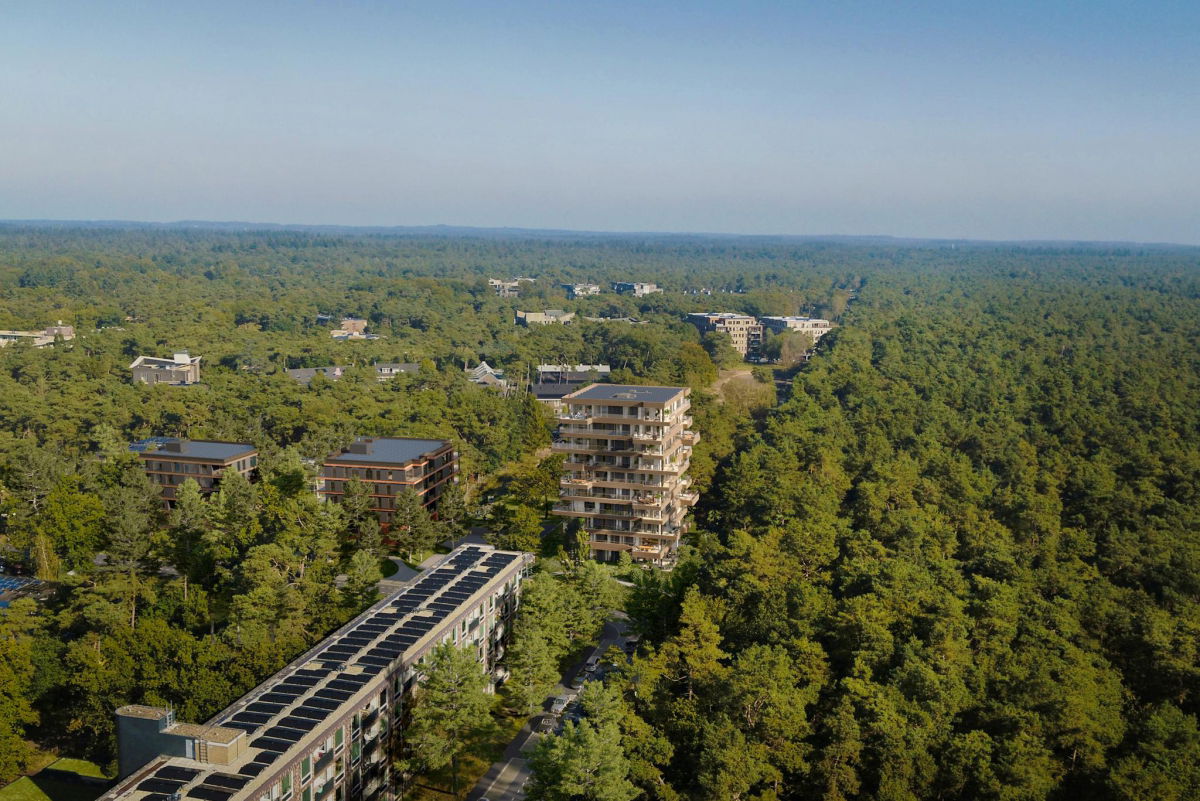
Thanks in part to the purchase, protection, restoration and management of forests and estates by the Utrechts Landschap, we can continue to enjoy all this beauty now and in the future.
You can find many more beautiful photos in the gallery of the website.
Zeist is so beautiful and how lucky we are to live here.
Until the next walk at the Lommerlust country estate, Arnie Della Rosa